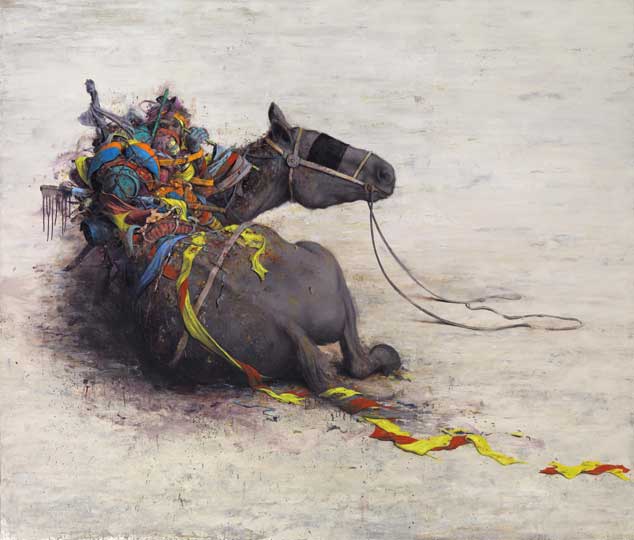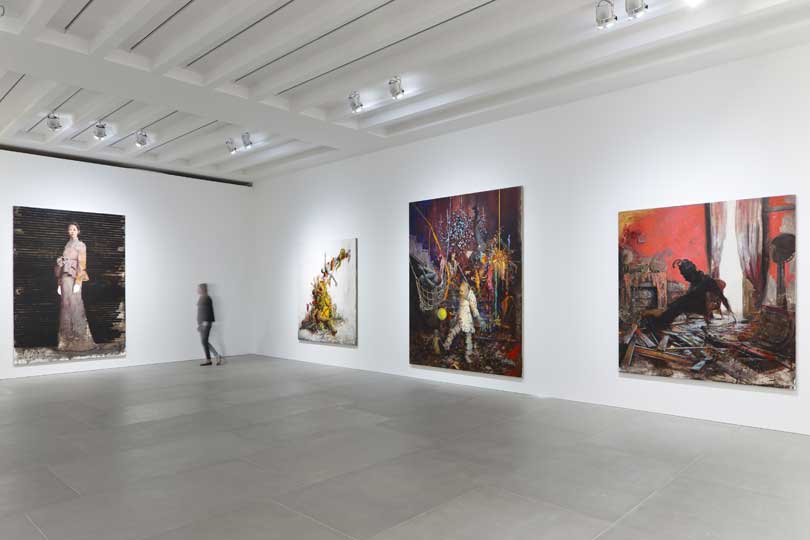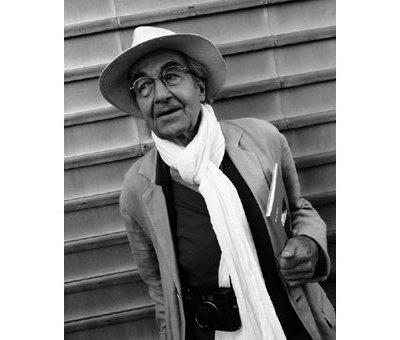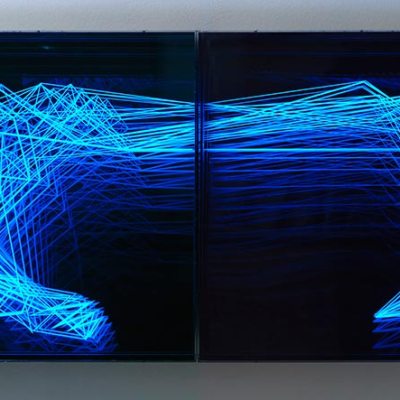I first visited Jonas Burgert’s exhibition at Blain|Southern on the opening night. The gallery crawled with people, while the monumental paintings on the walls seemed just as crowded – with ghosts. Ghosts of the traditionally nightmarish sort – waifs with blurred faces and contorted limbs scramble over his monumental canvases – but also art-historical ones. Lost characters that could be from Goya or Daumier, from Velazquez or Bacon, stray into domestic interiors and nondescript landscapes in odd ensembles.
stück hirn blind (2014), Jonas Burgert © the artist. Image courtesy of the artist and Blain|Southern. Photo: Gunther Lepkowski, 2014

If the artist meant them to sneak in there, he doesn’t acknowledge it when I speak to him a few days later. ‘I don’t think about Bosch, but some people see it’, he says of the largest piece in the show, a vast and lurid landscape where strange figures pick over piles of junk, and an oversized pink wasp lies belly up in its death throes. ‘The idea was just to make a mountain of trash…the worst place you can have. But I’m also trying to invent a spiritual procedure. You see that something has happened, you see the beautiful dirt of it, and you ask, why is it like that?’ The painting fills an entire wall, with as spectacular an effect as traditional religious works on the same scale. ‘In a way it’s an abstract religion. I’m not a religious person, but I’m interested in this phenomenon: why do we have this need to create gods all the time, to look for meaning?’ Perhaps I wasn’t completely off target with Bosch, whose gardens of delights and fields of punishment cultivate just such a sense of strange – or estranged – ritual.
We move on to something quieter; a squat canvas in which a packhorse sits dejectedly on a featureless white ground, laden with more neon junk. ‘The horse as an animal is very pure’, Burgert explains, ‘the idea here was to show all the things humans project onto it, as a big abstract disaster’. Horses have been co-opted into human history for millennia, painted again and again into our stories – Burgert’s looks exhausted and more than a little bored by it all. Again, it seems strangely familiar, like one of Goya’s mules or Picasso’s wounded greys: but again the artist questions the reference. ‘Sure, I don’t have my own horse so I looked at pictures’, he explains. ‘I didn’t want it to be like a classical horse, I wanted to show this breakdown. Imagine – the horse is really much stronger than we are, but this poor animal is following our lines all the time.’
puls fuhrt (2014), Jonas Burgert © the artist. Image courtesy of the artist and Blain|Southern. Photo: Gunther Lepkowski, 2014

I venture one more allusion, when we reach a work in the adjoining room. In it, figures draped in ribbons and standards are piled one top of each another. One of them holds up a spear with a torso skewered on the end, and a thin boy – grey and featureless, his arms outstretched and legs bound – seems caught on it too, so that he protrudes, weirdly weightless, from the top of the heap. Surely a reference to Goya’s horrors of war, to bodies draped over stumpy trees? He deflects again, but does offer me two broken doll-like figures at the base of the pile, which he first encountered on a public fountain in Paris.
I consider clarifying to him that I’m making all these associations in a positive way. As an artist Burgert is steeped – and unusually proficient – in the traditions of painting. Whatever you make of his outlandish compositions, they are technical masterclasses; slow accumulations of glazes and touched-up details, overlaid with neon scribbles and spills. He knows his stuff, and the Old Master ghosts I keep glimpsing are powerful echoes rather than derivative quotes; his works are of the same lineage. But to him I suspect they’re just incidental notes in a much, much bigger score. Other people might spot references to popular culture, to fantasy genres, horror, legends, urban myths; they’d all be equally right, and equally wrong. ‘It’s just a question of your mind’, as he puts it – a symptom of that instinctive search for meaning that so engrosses him.
Installation view: ‘Jonas Burgert’ at Blain|Southern, 2014. Image courtesy of the artist and Blain|Southern. Photo: Peter Mallet

I give up the art-historical game and ask him what he makes of his figures, at once so horrifying and so oddly pathetic. All of Burgert’s works seem to grapple with more than they can safely contain, and he talks with the same irrepressible energy about them. ‘You don’t see anything really bad – no splatter or horror. I don’t like that sort of thing’, he claims, somewhat to my surprise. ‘But there’s something very serious in life; we all have to handle it. We are living with all this advertising and entertainment around us, but we all know – when we are alone at home and close the door – that we will die.’ The same seriousness, he explains, pervades the best things in life: nobody laughs at love or friendship or beauty, but feels them intensely. We spend most of our lives stuck somewhere in between. ‘I think in the back of our minds we know there are phenomena we have no idea about…but we have an agreement just not to think about it all the time.’ The chaos and confusion in Burgert’s paintings lifts the lid on that awareness just a little, and looks it in the eye.
Is this why we’re so compelled as a species to create images, to turn to art? (We’re back to art history, I can’t help myself. Daumier’s Man on a Rope has just dropped down into a composition on our right but I leave him hanging there). ‘Yeah, for sure. We are living with illusions, and that’s why we are able to follow the illusion of a painting…We trust the lies, we want to trust the lies, and really I think the best lie we have is art.’
‘Jonas Burgert: STÜCK HIRN BLIND’ is at Blain|Southern, London, until 22 November.



